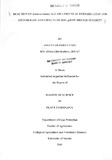| dc.contributor.author | Anginyah, J T | |
| dc.date.accessioned | 2013-05-03T13:42:33Z | |
| dc.date.available | 2013-05-03T13:42:33Z | |
| dc.date.issued | 2000 | |
| dc.identifier.citation | Anginya, J.T.(2000). Reaction of ipomoea batatas (l) lam lines to alternaria leaf and stem blight and effects of soil ph on disease severity | en |
| dc.identifier.uri | http://erepository.uonbi.ac.ke:8080/xmlui/handle/123456789/18783 | |
| dc.description | Msc-Thesis | en |
| dc.description.abstract | This study was carried out to determine the causal agent of blight disease on leaf petiole
and stem of sweetpotato in different agro-ecological zones in Kenya, investigate its
optimal in-vitro growth and sporulation conditions and determine the importance of the
pathogen in disease development under different soil pH levels as well as field
conditions. A total of 5 different zones were visited. Diseased leaf and vine tissues were
collected and pathogen isolated. The Kabete, Kakamega, Busia (Alupe), and Kabondo
isolates were identified as Alternaria bataticola while the Kisii isolate was identified as
Alternaria alternata. The Kabete isolate was more virulent than other isolates and other
species also.
A. bataticola grew rapidly and sporulated abundantly on host based media; sweetpotato
vine decoction media (SPVDM) and sweetpotato leaf decoction media (SPLDM) as
opposed to potato dextrose agar (PDA) and malt extract agar (MEA). Significant
mycelial growth occurred under alkaline pH ranges {pH 7 (71.67mm), 8 (71.81mm) and
9 (71.90mm)} while abundant sporulation occurred at acidic pH levels with optimal level
at pH 5.6 (2.03 x 106 conidia/ml) on SPVDM. But, with prolonged incubation period,
there was decline in sporulation at all pH levels tested.
12hrs continuous light alternating with 12hrs continuous darkness (12hrsL/12hrsD)
sustained the highest sporulation while 24hrs continuous light (24hrsL) enhanced a better
mycelial growth and 24hrs continuous darkness (24hrsD) sustained the lowest mycelial
growth and supported less sporulation. Alternaria bataticola grew optimally at
temperatures between 26°C and 28°C. Yields of conidia obtained from cultures washed
by 10ml of water ranged from 1.83 x 106 conidia/ml at 28°C to 0.33 x 106 conidia/ml at
34°C. The ability of the fungus to sporulate declined at higher temperatures.
Pathogenicity and virulence of different isolates of A. bataticola and A. alternata from
diseased samples were investigated under greenhouse conditions. Within 4 - 6 days
following artificial inoculation, and depending on sweetpotato cultivar, the fungus
produced characteristic symptoms typical of Alternaria leaf petiole and stem blight. All
the isolates were pathogenic and differences in virulence depended on isolate source and
conidial concentration. The Kabete isolate was more virulent than Kakamega, Kabondo
and Alupe isolates, whose virulence did not differ significantly from each other (P<0.05).
The effect of soil pH on disease severity in some cultivars of sweetpotato was also
evaluated under greenhouse conditions. There was no significant difference among the
levels of soil pH tested on disease severity (P<0.05). The mean disease severity for soil
pH 4.4, 4.6 and 6.7 were same (3.42) and for soil pH 7.6 was 3.25. There were
significant differences in disease severity among the cultivars evaluated.
Alternaria leaf and stem blight caused by Alternaria bataticola was monitored in field
plots of sweetpotato accessions selected from the CIP gerrnplasm collection field.
Disease severity was measured as percent infected area and used to compute area under
disease progress curves (AUDPC). AUDPC's revealed distinct differences in disease
infection among the accessions evaluated (p=0.05). Cultivars Viola (440046) and
Yanshu 1 (440024) were more susceptible to the pathogen than other entries tested. The
lowest disease levels were observed on cultivar Jayalo in both seasons. | en |
| dc.description.sponsorship | University of Nairobi | en |
| dc.language.iso | en | en |
| dc.subject | Ipomoea batatas (l) | en |
| dc.subject | Lam lines | en |
| dc.subject | Alternaria leaf and stem blight | en |
| dc.subject | soil ph | en |
| dc.subject | Disease | en |
| dc.title | Reaction of ipomoea batatas (l) lam lines to alternaria leaf and stem blight and effects of soil ph on disease severity | en |
| dc.type | Thesis | en |
| local.publisher | Department of Plant Science and Crop Protection, University of Nairobi | en |

